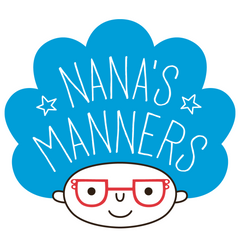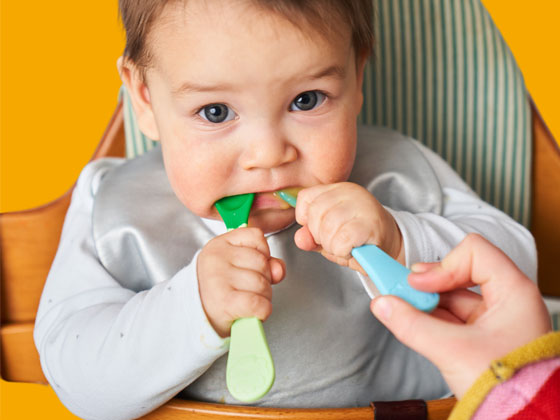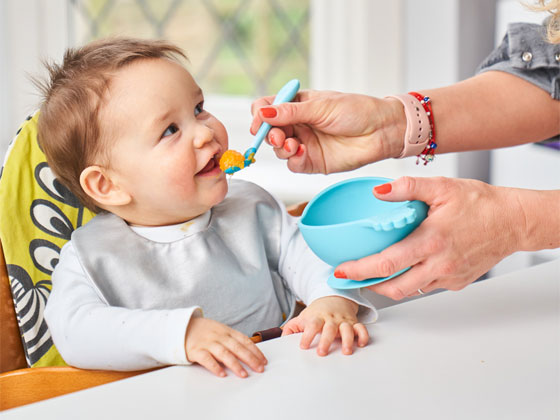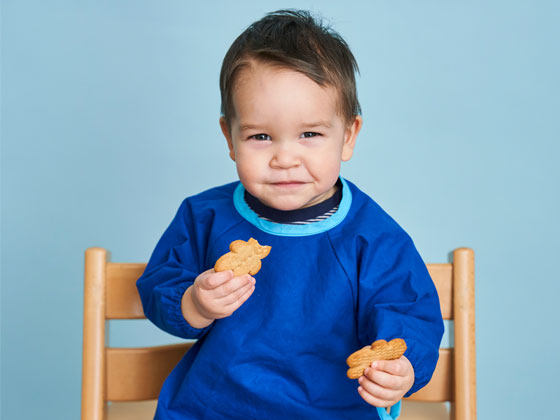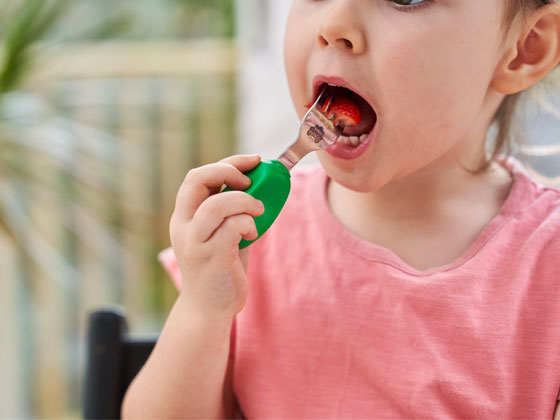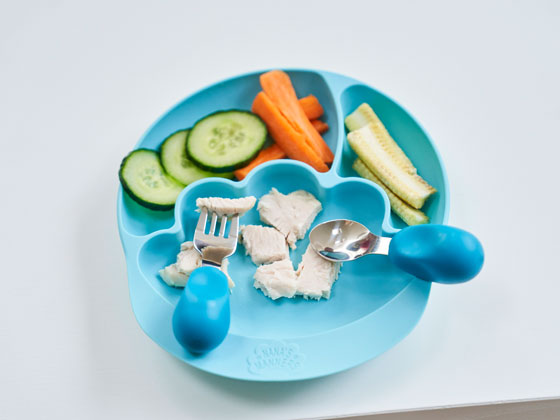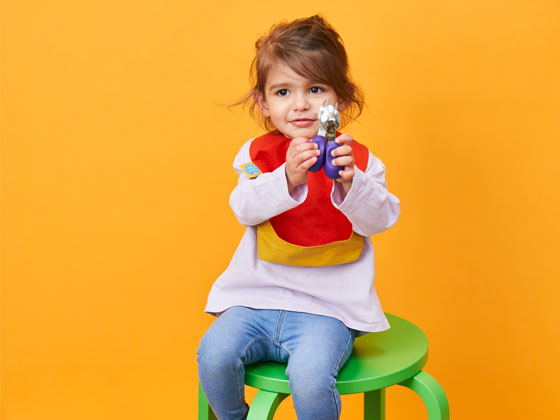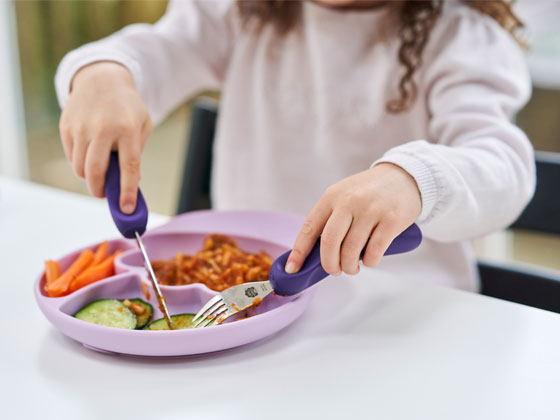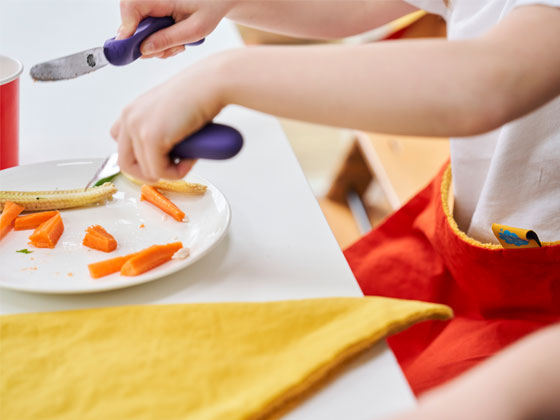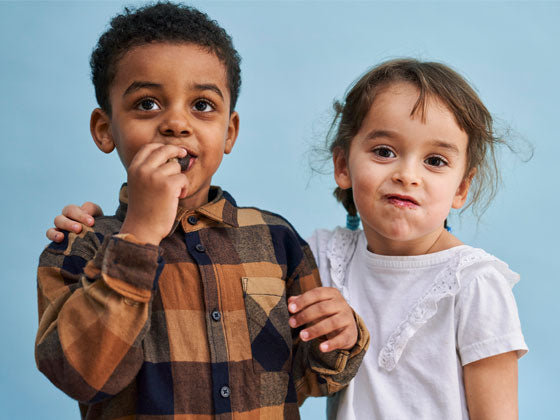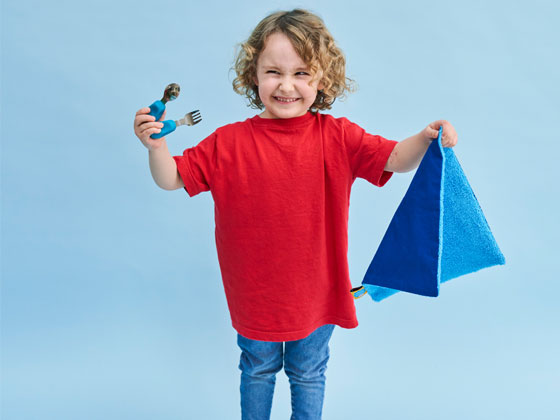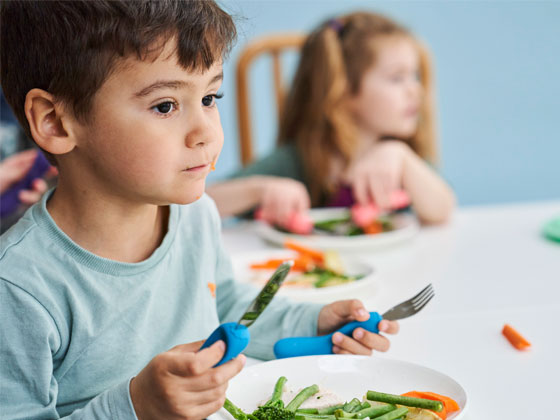FAQs
Babies are often keen to get involved in feeding themselves from
6-9 months. Between 9 and 13 months their hand-to-mouth co-ordination will be developing and they will start to be able to finger feed themselves with soft foods.
Between 12 and 24 months children are often keen to be feeding themselves independently. They will have been watching you eating closely and keen to copy what they see! This is a good point to introduce a spoon first for eating soft, but not too runny foods, such as thicker yogurts. These will be more likely to stay on the spoon in the journey from the pot to their mouth! Our Stage 2 cutlery handles are designed perfectly for little hands and the unique shape supports your child’s grip as it develops over this time. Once they are enjoying using the spoon, a fork can then be introduced to allow them to stab small pieces of soft food, such as cooked vegetables, cut up to the size suitable for them to eat. It is normal for children to get to grips with a fork slightly later, often 2-3yrs old. It will take them some time to realise the job the fork does, versus the spoon, but they’ll have great fun discovering this
on their journey!
Using a knife and fork in co-ordination is a significant step in their fine motor skill development. From 3yrs - 5yrs old, children are learning to cut and spread with a knife. It can take some time beyond this before they are completely independent and confidently cutting up all their meals and eating truly all by themselves. Our Stage 3 cutlery is routinely used by children from 3yrs – 10yrs old to support their fine motor skill development and independent eating.
Eating with fingers is the natural first step for any baby. It is the most effective way to eat certain foods; as adults many of us still get sticky fingers tucking into pizza, burgers and chips! Learning to eat with cutlery is an important step in child development. When children start school, many will have hot lunches and be expected to cut up and eat their food independently. Not being able to use cutlery at this point would be a hindrance – there are simply not enough staff to be cutting up every child’s food in the dinner hall!
Using a knife and fork correctly involves the ‘tri-grip’ – using the thumb and first two fingers on each hand. These are the same muscles used in pencil grip and using cutlery is an excellent way to support fine motor skill development. Many Occupational Therapists use and recommend our Stage 3 cutlery for exactly this
reason. This is also why is it used in nurseries and schools. Using it for 20 minutes for two meals a day adds up to a good few hours of extra fine motor skill practice each week!
There are other reasons this is important too. Encouraging children to be fully engaged and part of mealtimes helps support the development of a healthy attitude towards food as well as developing their social skills. If they are physically confident in their ability to eat what is on their plate they will be more likely to try new foods and persevere in eating more of what is served to them.
If You Thought The Weaning Stage Was Messy Things Are About To Step Up A Notch! They Will Likely Become Determined To Feed Themselves So Be Prepared – It Is Wonderful To Watch! A Good Bib (And Avoiding White Clothing In General) Is A Good Tip. You Will Also Need A Plate That Stays Put On The Table – One With Good Sides That They Can Use To Help Them Scoop Food Onto Their Spoon And Stops The Food Rolling Away When They Use The Fork Is Essential.
It is important to support your child physically when they are learning a new skill. Sit them at a table in a chair that supports their back. It is also important that their feet are on the floor. Next time you eat with a knife and fork try lifting your feet into the air as you do it – tough to balance isn’t it?! A chair that supports their feet is great. If you don’t have one, then placing a box on the floor under their feet does the job.
Setting the table in the same way with the utensils in the same place will help them familiarise themselves with the process and make them more comfortable, knowing what to expect at each meal.
Use a bowl or plate with higher sides when they are learning to scoop with a spoon or a fork. This will help them get the food onto the utensil more easily. Our Stage 1 bowls and Stage 2 Plates are designed just for this!
For older ones, use a plate with raised size to help keep the food on the plate as they’re learning to cut, but ensure the sides are not too raised to limit the angle of the knife.
Start as you mean to go on. Using our finger stickers that come with our Stage 3 sets for the first few uses ensures that your child will place their index fingers correctly. The shape of the handles will then support everything else. The stickers allow your child to discover this grip for themselves and they will then automatically pick up their cutlery in this way in no time at all.
When learning to cut, start with softer foods then move to firmer ones once they are more confident holding the food with the fork and cutting with the knife.
Practice makes perfect! Everyone learns at their own pace. Keep up the consistency and practice as often as possible. Why not use play-dough if they are keen to use their cutlery between meals!
Why Nana’s Manners?

Happy,
Confident Kids

Love Learning,
For Life

Multi
Award-Winning

Valued By Parents
Loved By Children
